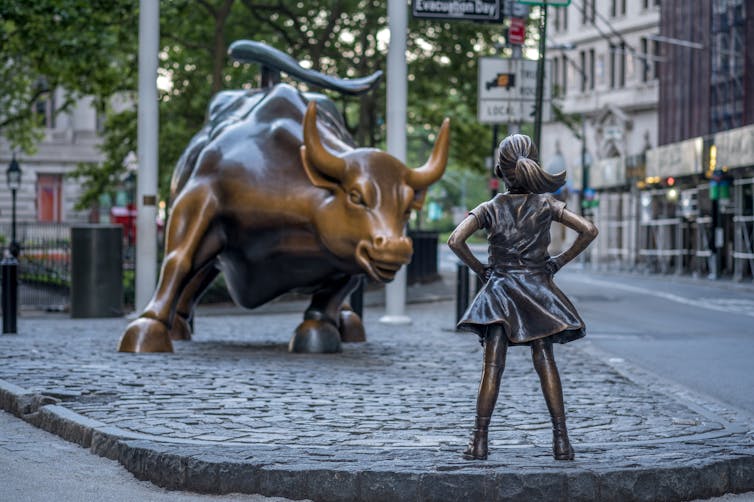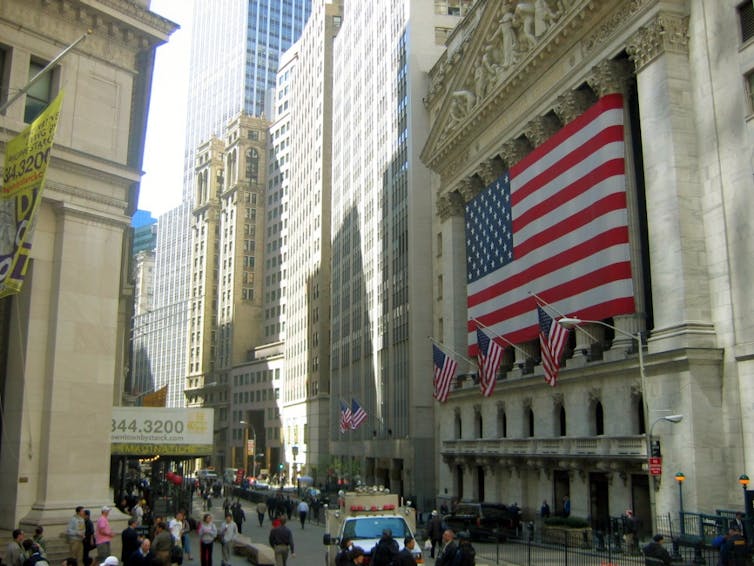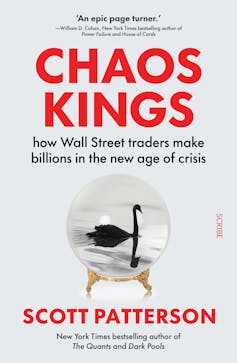Dean of UTS Business School Professor Carl Rhodes reviews the book 'Chaos Kings: How Wall Street Traders Make Billions in the New Age of Crisis' by Scott Patterson.

‘Charging Bull’ and ‘Fearless Girl’ sculptures outside the New York Stock Exchange. Shutterstock
Chaos Kings: How Wall Street Traders Make Billions in the New Age of Crisis chronicles the cold-blooded response of Wall Street to the COVID pandemic. New York finance journalist Scott Patterson reports how savvy investors used the devastation of the pandemic to reap billions in profits.
Combining insider access with masterful storytelling, Patterson’s meticulously researched book tells the tales of the investors, scientists and mathematicians whose creativity, expertise and risk-taking created financial opportunities out of a worldwide disaster that killed millions.
Review: Chaos Kings: How Wall Street Traders Make Billions in the New Age of Crisis (Scribner)
Chaos Kings is not so much about the rapacious “greed is good” mentality of the 1980s. In 2021, the prevailing attitude was more like “greed is amoral”, technical even. As the profits flowed from the COVID disaster, there was little hint of any ethical quandary. All stops were taken out in the pursuit of profit from pain.
The most disconcerting aspect of Patterson’s account is how the men who did this (they are all men) are generally presented as quite sympathetic, if flawed, characters. On the one hand, Patterson presents them as unique, each one something of a stock-market superman. On the other hand, they remain human, all too human.
Patterson not only renders the work of finance high-flyers as understandable as possible to the layperson, he makes them relatable as human beings. They were horrified by the carnage around them, but carried on with the job of buying and selling stocks and bonds to cash in on the catastrophe.
Chaos kings is the name Patterson gives these people, because they thrive on disaster, exploiting it to beat the financial markets they play in. Masculinity comes out in full force as the kings strive to be the best and the smartest, as if literally vying for position of finance monarch.
They are the “winners” determined to be the biggest dogs in the pack, but theirs is not a masculinity of brute force. It is that of unbridled free-market competition. This competition is revealed as an almost infinitely larger version of the school playground where boys jostle for pole position in childish games, the consequences of which are far from childish.
The COVID casino
In the pages of Patterson’s book, we meet colourful characters from up and down Wall Street who closely studied the illness and death spawned by COVID as it spread around the world. They worried about the pandemic; they were concerned about how government could control it. But most of all, they were “the smartest guys in the room”, who used it for their own financial gain.
Nassim Taleb, Bill Ackman, Yaneer Bar-Yam, Mark Spitznagel – these are not household names. But they all won big in the pandemic casino by operating as crisis-hunting “stock market visionaries”.
Theirs was not a random spin on the roulette wheel, but the calculated bluffing of the seasoned poker player. With inestimable grace under pressure, they were hellbent on recognising the “black swan” of unpredictable events like the pandemic, using that recognition to make counter-intuitive trading decisions and stay ahead of the game.
Patterson’s chaos kings succeeded because they had the courage to defy conventional wisdom. A combination of maverick intelligence and steely nerve saw them consolidating while others diversified, buying while others sold, taking risks while others played it safe. Above all, they were cool while those around them panicked.
Others saw the pandemic as a “dragon king”: a rare and powerful event that leads to disastrous outcomes. The trick was to see the dragon coming before anyone else, and to outsmart it for one’s own benefit.
The Wall Street winners moved early, capitalising on the uncertainty. They gained early and special knowledge of the pandemic to outsmart their rivals. Their arsenal of techniques included theoretical sophistication, savant-like mathematical skills, and a deep yet unconventional understanding of markets.
The investors who failed to capitalise on chaos were wracked with envy – jealous they did not have the skills, nerve or knowledge to make the same bets.
 The New York Stock Exchange, where the ‘chaos kings’ exploited the uncertainty of the pandemic. Wikimedia Commons, CC BY-SA
The New York Stock Exchange, where the ‘chaos kings’ exploited the uncertainty of the pandemic. Wikimedia Commons, CC BY-SA
On the doorstep of doom?
Many of the chaos kings were schooled in crisis profiteering during the 2008 Global Financial Crisis. They learned, too, from the 1987 Black Monday crash. But those events were small-time in comparison to what was happening in 2020.
COVID offered an opportunity of unprecedented proportions, and the chaos kings looked at it as having even more potential upside than the Wall Street crash that spawned the great depression in the 1930s – upside for them, at least, as they were able to win while everyone else was losing.
A times, Patterson’s storytelling takes on the character of well-written objective reportage. But his book also reads, in some ways, like a set of interconnected fictional short stories, filled with thrilling twists, turns and revelations.
The plots err towards being heroic, Odyssean even. Tale after tale is recounted about the up-and-down adventures of the chaos kings, who prance around the world’s stage, from New York to London and Davos, and beyond. The Wall Street protagonists undertake epic journeys, fight mythical beasts and weather calamitous acts of nature, only to return home stronger and richer men. They are the financial victors in a world of losers.
But Chaos Kings is not fiction and Patterson does not entirely accept his own heroic narrative. He also alerts us to its tragic side, its pathos even. Beyond any putative heroism, Patterson appears keenly aware that making heroes out of a small handful of financial winners offers no salvation for the victims of the catastrophe.
He ends pessimistically, stating that we remain on the “doorstep of doom”. Between the pandemic, the climate crisis and the increasingly unpredictable geopolitics represented by the Russian invasion of Ukraine, Patterson seems resigned to our dismal collective fate. He is a keen observer of the world, deftly recording its demise with precision and panache.
Chaos Kings provides a superb, if harrowing, account of people who profit from catastrophe and the broken lives of people they will never meet or see. These are “crisis hunters” who hide behind cold computer screens, playing with other people’s lives as if they were meaningless pieces in a parlour game for the wealthy elite.
Read it and weep.![]()
Carl Rhodes, Professor of Organization Studies, University of Technology Sydney
This article is republished from The Conversation under a Creative Commons license. Read the original article.


